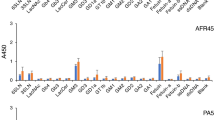Abstract
Two monoclonal antibodies, specific for A type 3 and A type 4 blood group determinants, are described. These antibodies recognized A1 but not A2 erythrocytes. A third monoclonal antibody showing specificity for A type 3 and A type 4, and also for H type 3 and H type 4, did not discriminate between A1 and A2 erythrocytes. On red cells these three antibodies recognized glycosphingolipids and binding to glycoproteins could not be demonstrated. On paraffin-embedded tissue sections the three antibodies labelled a supranuclear area, characteristic of the Golgi apparatus, of all cells producing A antigens. This labelling occurred irrespective of the A1, A2 status.
The results suggest that glycolipids of erythrocytes and possibly of other cell types bear the A type 3/4 determinant specific for the A1 subgroup and that A type 3/4 determinants of glycoproteins might be present in both A1 and A2 subgroups on short oligosaccharide chains which are only detectable at the level of the Golgi apparatus.
Similar content being viewed by others
References
Watkins WM (1980) Adv Hum Genet 10:1–136.
Mollicone R, Le Pendu J, Bara J, Oriol R (1986) Glycoconjugate J 3:187–202.
Donald ASR (1981) Eur J Biochem 120:243–49.
Takasaki S, Yamashita K, Kobata A (1978) J Biol Chem 253:6086–91.
Clausen H, Watanabe K, Kannagi R, levery SB, Nudelman E, Arao-Tomono Y, Hakomori S (1984) Biochem Biophys Res Communn 124:523–29.
Clausen H, Levery SB, Nudelman E, Tsuchiya S, Hakomori S (1985) Proc Natl Acad Sci USA 82:1199–203.
Breimer ME, Jovall PA (1985) FEBS Lett 176:165–72.
Breimer ME, Samuelsson BE (1986) Transplantation 42:88–90.
Mohn JM, Cunningham RK, Bates JE (1977) in Human Blood Groups, eds. Mohn JM, Plumkett RW, Cunningham RK, Lambert RM, Karger, Basel, p 316–25.
Kisailus E, Kabat EA (1978) J Exp Med 147:830–43.
Fujii H, Yoshida A (1980) Proc Natl Acad Sci USA 77:2951–54.
Watkins WM, Morgan WTJ (1957) Acta genet statis med 6:521–26.
Mäkela O, Ruoslahti E, Ehnholm C (1969) J Immunol 102:763–71.
Koscielak J, Miller-Podraza H, Krauze R, Piasek VA (1976) Eur J Biochem 71:9–18.
Köhler G, Milstein C (1975) Nature 256:495–97.
Stähli C, Staehelin T, Miggiano V, Schmidt J, Häring P (1980) J Immunol Methods 32:297–304.
Oriol R, Binaghi R, Boussac-Aron Y (1968) Ann Inst Pasteur 114:713–26.
Greenwood FC, Hunter WM, Glover JS (1963) Biochem J 89:114–23.
Lemieux RU (1978) Chem Soc Rev 7:423–52.
Lemieux RU, Baker DA, Bundle DR (1977) Can J Biochem 55:507–12.
Mollicone R, Bara J, Le Pendu J, Oriol R (1985) Lab Invest 53:219–27.
Oriol R, Mancilla-Jimenez R (1982) J Immunol Methods 62:185–92.
Falk KE, Karlsson KA, Samuelsson BE (1981) FEBS Lett 124:173–77.
Hansson GC, Karlsson KA, Larsson G, McKibbin JM, Blaszczyk M, Steplewski Z, Koprowski H (1983) J Biol Chem 258:4091–97.
Magnani JL, Smith DF, Ginsburg V (1981) Anal Biochem 109:399–402.
Clausen H, Levery SB, Kannagi R, Hakomori S (1986) J Biol Chem 261:1380–87.
Furukawa K, Clausen H, Hakomori S, Sakamoto J, Look K, Lundblad A, Mattes MJ, Lloyd KO (1985) Biochemistry 24:7820–26.
Le Pendu J, Lemieux RU, Dalix AM, Lambert F, Oriol R (1983) Vox Sang 45:349–58.
Le Pendu J, Oriol R, Lambert F, Dalix AM, Lemieux RU (1983) Vox Sang 45:421–25.
Slomiany BL, Zdebska E, Slomiany A (1984) J Biol Chem 259:2863–69.
Clausen H, Holmes E, Hakomori S (1986) J Biol Chem 261:1388–92.
Lemieux RU, Baker DA, Weinstein WM, Switzer CM (1981) Biochemistry 20:199–205.
Le Pendu J, Lemieux RU, Lambert E, Dalix AM, Oriol R (1982) Am J Hum Genet 34:402–15.
Graham HA, Hirsch HF, Davies DM (1977) in Human Blood Groups, eds. Mohn JM, Plumkett RM, Cunningham RK, Lambert RM, Karger, Basel, p 257–67.
Author information
Authors and Affiliations
Rights and permissions
About this article
Cite this article
Le Pendu, J., Lambert, F., Samuelsson, B. et al. Monoclonal antibodies specific for type 3 and type 4 chain-based blood group determinants: Relationship to the A1 and A2 subgroups. Glycoconjugate J 3, 255–271 (1986). https://doi.org/10.1007/BF01051776
Received:
Issue Date:
DOI: https://doi.org/10.1007/BF01051776




